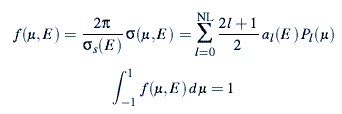
|
|
|
The following is based on ENDF-102, Data Formats and Procedures for the Evaluated Nuclear Data File ENDF-6. File 4 is used to describe the angular distribution of emitted particles. It is used for reactions with incident neutrons only; see File 6 for for other projectiles. Angular distributions should be given for elastically scattered neutrons and for the neutrons resulting from discrete level excitation due to inelastic scattering. File 4 can also be given for particles resulting from (n,n'continuum), (n,2n), and other continuum reactions, but in these cases only the integral over all final energies is provided. There is normally coupling between the secondary energy and angle in these cases, and File 6 is preferred. File 4 may also contain angular distributions of emitted charged particles for a reaction where only a single outgoing charged particle is possible (MT=600 through 849). In some cases, it may be possible to compute the angular distributions in the resolved range from resonance parameters. In such cases, the computed distributions may be preferable to the distributions from File 4, which will be a smoothed average when the resonances are close together. Angular distributions for a specific reaction type (MT number) are given for a series of incident energies, in order of increasing energy. The energy range covered should be the same as that for the same reaction type in File 3. Angular distributions for several different reaction types (MT's) may be given in File 4 for each material in ascending order of MT number. The angular distributions can be expressed as normalized probability distributions or as Legendre expansions of the probability distributions: |

where f(μ,E)dμ
is the probability that a particles of incident energy E will
be scattered into the interval dμ about
an angle whose cosine is μ. The units of
f(μ,E) are (unit cosine)-1.
In addition,
Formats File 4 is divided into sections, each containing data for a particular reaction type (MT number), and ordered by increasing MT number. Each section always starts with a HEAD record and ends with a SEND record. The following quantities are defined:
The structure of a section depends on the values of LTT. Legendre Polynomial Coefficients
|
[MAT, 4, MT/ ZA, AWR, LVT, LTT, 0, 0] HEAD LVT=0, LTT=1
[MAT, 4, MT/ 0., AWR, LI, LCT, 0, 0] CONT LI=0
[MAT, 4, MT/ 0., 0., 0, 0, NR, NE/ Eint] TAB2
[MAT, 4, MT/ 0., 0., 0, 0, NL, 0/ a_l(E_1)] LIST
[MAT, 4, MT/ 0., 0., 0, 0, NL, 0/ a_2(E_2)] LIST
...
[MAT, 4, 0/ 0.0, 0.0, 0, 0, 0, 0] SEND
|
Tabulated Probability Distributions
|
[MAT, 4, MT/ ZA, AWR, LVT, LTT, 0, 0] HEAD LVT=0, LTT=2
[MAT, 4, MT/ 0., AWR, LI, LCT, 0, 0] CONT LI=0
[MAT, 4, MT/ 0., 0., 0, 0, NR, NE/ Eint] TAB2
[MAT, 4, MT/ 0., 0., 0, 0, NR, NP/ muint/ f(mu,E_1)] TAB1
[MAT, 4, MT/ 0., 0., 0, 0, NR, NP/ muint/ f(mu,E_1)] TAB1
...
[MAT, 4, 0/ 0.0, 0.0, 0, 0, 0, 0] SEND
|
All Angular Distributions are Isotropic
|
[MAT, 4, MT/ ZA, AWR, LVT, LTT, 0, 0] HEAD LVT=0, LTT=0
[MAT, 4, MT/ 0., AWR, LI, LCT, 0, 0] CONT LI=1
[MAT, 4, 0/ 0.0, 0.0, 0, 0, 0, 0] SEND
|
Procedures The angular distributions for two-body reactions should be given in the CM system (LCT=2). It is recommended that other reactions (such as continuum inelastic, fission, etc.) should be given in the LAB system. For Legendre polynomial expansions, a linear-linear interpolation scheme (INT=2) should be used for the incident energy. For tabulated distributions, the cosine interval should span the entire range -1 to +1. The interpolation scheme for incident energy E should be linear-linear (INT=2) and the interpolation scheme for the cosine should be log-linear (INT=4).
|
| NEXT | INDEX | ||
| 15 December 2012 | T-2 Nuclear Information Service | ryxm@lanl.gov |